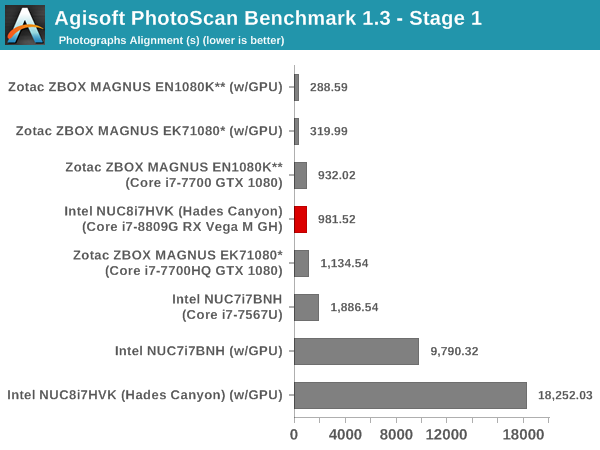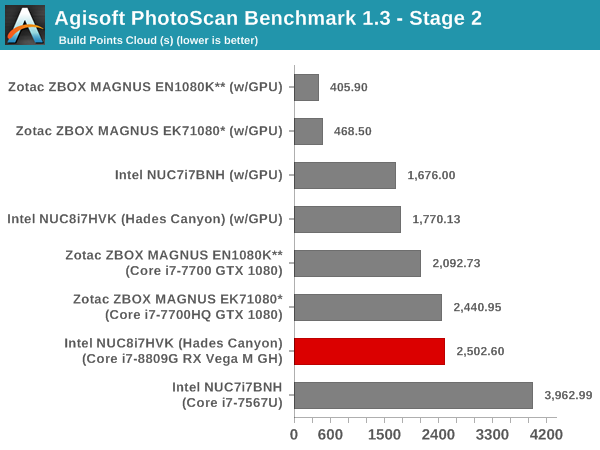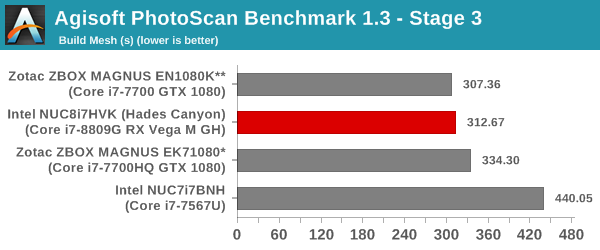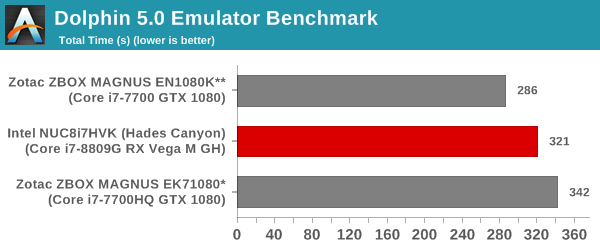The Intel NUC8i7HVK (Hades Canyon) Review: Kaby Lake-G Benchmarked
by Ganesh T S on March 29, 2018 1:00 PM ESTPerformance Metrics - II
In this section, we mainly look at benchmark modes in programs used on a day-to-day basis, i.e, application performance and not synthetic workloads.
x264 Benchmark
First off, we have some video encoding benchmarks courtesy of x264 HD Benchmark v5.0. This is simply a test of CPU performance. As expected, the Core i7-8809G with its 65W processor TDP slots closer to the Core i7-6700 and the Core i7-7700. Recent releases of the x264 benchmark can show even more impressive gains, as they make use of the latest and greatest features of the modern Intel processors.


7-Zip
7-Zip is a very effective and efficient compression program, often beating out OpenCL accelerated commercial programs in benchmarks even while using just the CPU power. 7-Zip has a benchmarking program that provides tons of details regarding the underlying CPU's efficiency. In this subsection, we are interested in the compression and decompression MIPS ratings when utilizing all the available threads. The performance order is similar to the one encountered in the x264 benchmark.


TrueCrypt
As businesses (and even home consumers) become more security conscious, the importance of encryption can't be overstated. CPUs supporting the AES-NI instruction for accelerating the encryption and decryption processes have become more widespread over the last few years. TrueCrypt, a popular open-source disk encryption program can take advantage of the AES-NI capabilities. The TrueCrypt internal benchmark provides some interesting cryptography-related numbers to ponder. In the graph below, we can get an idea of how fast a TrueCrypt volume would behave in the Intel NUC8i7HVK (Hades Canyon) and how it would compare with other select PCs. This is a purely CPU feature / clock speed based test.

Agisoft Photoscan
Agisoft PhotoScan is a commercial program that converts 2D images into 3D point maps, meshes and textures. The program designers sent us a command line version in order to evaluate the efficiency of various systems that go under our review scanner. The command line version has two benchmark modes, one using the CPU and the other using both the CPU and GPU (via OpenCL). We have been using an old version of the program with 50 photogaphs in our reviews till now. The updated benchmark (v1.3) now takes around 84 photographs and does four stages of computation:
- Stage 1: Align Photographs (capable of OpenCL acceleration)
- Stage 2: Build Point Cloud (capable of OpenCL acceleration)
- Stage 3: Build Mesh
- Stage 4: Build Textures
We record the time taken for each stage. Since various elements of the software are single threaded, others multithreaded, and some use GPUs, it is interesting to record the effects of CPU generations, speeds, number of cores, DRAM parameters and the GPU using this software.
The GPU-enabled numbers for Stage 1 and 2 below are with the use of the Intel HD Graphics 630, since our benchmark version only supports use of the first enumerated GPU. Unfortunately, when we tried to disable the integrated GPU and use only the discrete GPU after changing the BIOS setting, the benchmark consistently crashed while starting the first stage itself.




Dolphin Emulator
Wrapping up our application benchmark numbers is the new Dolphin Emulator (v5) benchmark mode results. This is again a test of the CPU capabilities, and the Core i7-8809G slots inbetween the 45W TDP Core i7-7700HQ and the 65W Core i7-7700.











124 Comments
View All Comments
cacnoff - Thursday, March 29, 2018 - link
I see that it can play back netflix 4k HDR?Does this make Intel the first Radeon GPU implementation to handle Playready 3.0?
patrickjp93 - Friday, March 30, 2018 - link
Actually that's handled by the iGPU on Kaby Lake. Vega is not PlayReady 3.0-capable.ganeshts - Friday, March 30, 2018 - link
On traditional KBL systems, you are right about iGPU handling PlayReady 3.0 video decoding.On the Hades Canyon, it appears that the Vega GPU is handling it. I have updated the '4K HTPC Credentials' section with the appropriate text after capturing the screenshot below:
https://images.anandtech.com/doci/12572/Netflix-GP...
gigahertz20 - Thursday, March 29, 2018 - link
I've built two Intel NUC's for family members in the past couple of years and they love them. Fast, quiet and so far reliable. They don't game at all which is why I convinced them to buy them. I'm not sure if this NUC is going to be popular at all though at $1,000 barebones. Who is going to buy it? The gaming performance of this NUC is nothing special, gamers and enthusiasts are going to stick with desktops, alot of people are just waiting for the cryptocurrency craze to die down so we can get video cards at decent prices again. If that takes another year or 2 so be it.Your average person that just needs an office computer won't buy this at $1k, you can get a much cheaper NUC and throw in a SSD and that will work fine. Why pay a premium for a cute little powerful box, if you want small and portable you can get a laptop for cheaper. If they would have priced this at $600 barebones it would have been much more appealing to your average user that might want to play the occasional game at 1080P.
Crazyeyeskillah - Thursday, March 29, 2018 - link
Nuc's have always been geared as thing clients for businesses. It's a niche market that pretty much just wants reliability and 'good enough' performance. I don't see many people loading up on the $1700 version like we see here, but Intel will get good sales from the lowest tier when ordered by the hundreds for large companies.Sailor23M - Friday, March 30, 2018 - link
I bought the Skull Canyon version last year at a good discount on newegg. I am very happy with it and intel’s support (for at least the skull canyon) has been great with a dedicated website and easy to find updates, firmware and drivers. I have it mounted behind my monitor and use it as my main PC. I’m sure that although the retail price on these is $999, you will be able to find it for much less in a few months time.The_Assimilator - Thursday, March 29, 2018 - link
For the love of god Ganesh, please, PLEASE give us proper teardowns of the units you review. That means taking the damh things apart and showing us what all the bits look like, NOT just removing the lid that allows you to access the user-upgradable bits.Crazyeyeskillah - Thursday, March 29, 2018 - link
Why do you need a tear down of this product?The_Assimilator - Monday, April 2, 2018 - link
I don't "need" it, but a review should attempt to be as thorough as possible, and for hardware that means showing as much of the system as possible.cfenton - Thursday, March 29, 2018 - link
Usually review units are on loan from the manufacturer. They aren't typically too keen on reviewers tearing them apart before returning them.